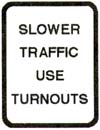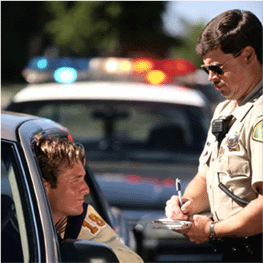Cal-Driver-Ed.Com |
|
California's Home Study Driver Education Class |
To easily find this site again, hit Ctrl+D, or drag this link: Cal-Driver-Ed to your Favorites.
| Log-In | Driver Education | Driver Training | DMV Requirements | FAQs | Compare | Contact Us |
|
The California DMV Driver Handbook |
Right-of-way rules help people drive safely. These rules go along with courtesy and common sense. Bicyclists, moped riders, and pedestrians must follow these rules, too. Never insist on taking the right-of-way. If another driver does not yield to you when he or she should, forget it. Let the other driver go first. You will help prevent accidents and make driving more pleasant. However, if another driver expects you to take your legal turn, take it. If you don’t, you may cause confusion and delay traffic. Pedestrian safety is a serious issue. One in six traffic fatalities is a pedestrian. Drive cautiously when pedestrians are near because they may cross your path. A pedestrian is a person on foot or who uses a conveyance such as roller skates, skateboards, etc., other than a bicycle. A pedestrian can also be a person with a disability in a self-propelled wheelchair, tricycle, or quadricycle. • Always stop for any pedestrian crossing at corners or other crosswalks. Do not pass a car from behind that has stopped at a crosswalk. A pedestrian you can’t see may be crossing. • Do not drive on a sidewalk, except to cross it at a driveway or alley. When crossing, yield to any pedestrian. • Remember—if a pedestrian makes eye contact with you, he or she is ready to cross the street. Yield to the pedestrian. • Pedestrians have the right-of-way at corners, whether or not the crosswalks are marked by painted white lines. Click here for information regarding pedestrians who are blind. • At an intersection without STOP or YIELD signs, slow down and be ready to stop. Yield to vehicles already in the intersection or just entering it. Also, yield to the car which arrives first or to the car on your right if it reaches the intersection at the same time as you do. At a “T” intersection, without STOP or YIELD signs, vehicles on the through road have the right-of-way. • When there are STOP signs at all corners, stop first; then follow the above rules. • When you turn left, give the right-of-way to all vehicles approaching you that are close enough to be dangerous. Look for motorcyclists, bicyclists, and pedestrians. On divided highways, or highways with several lanes, watch out for vehicles coming in any lane you must cross. Turn left only when you can see that it is safe. Whenever you park off the road or leave a parking lot etc., before you enter the road again, yield to traffic. California’s "Basic Speed Law" states never drive faster than is safe for current conditions, regardless of the posted speed limit. For more information, click here . The maximum speed limit on most California highways is 65 mph. However, for two-lane undivided highways and for vehicles towing trailers, the maximum speed limit is 55 mph, unless posted for a higher speed. On some highways the maximum speed limit is 70 mph, but only if there are signs posted showing 70 mph. Other speed limit signs are posted for the type of roads and traffic in each area. All speed limits are based on ideal driving conditions. Construction zones usually have reduced speed zones. Driving faster than the posted speed limit, or than it is safe for current conditions, on any road is dangerous and illegal. High speed increases your stopping distance. The faster you go, the less time you have to avoid a hazard or accident. The force of a 60 mph crash isn’t just twice as great as at 30 mph, it’s four times as great! *Remember, you may not drive faster than the posted or maximum speed limit, even if you think it is safe to do so. There are times when you must drive slowly because of heavy traffic or bad weather. However, if you block the normal and reasonable movement of traffic by driving too slowly, you may receive a ticket. When you drive slower than other traffic, do not drive in the “fast” lane. Move to the right when another driver is close behind you and wishes to drive faster. When you drive a bus, tow a vehicle or trailer, or drive a truck with three or more axles, you will be traveling slower than other vehicles. You must drive in the right-hand lane or in a lane specially marked for you. If no lanes are marked and there are four lanes in your direction, you may only drive in either of the two lanes closest to the right side of the road. Around children: • Always drive more carefully near schools, playgrounds, parks, and residential areas because children may suddenly dart into the street. Within 500 feet of a school, the speed limit is 25 mph while children are outside or crossing the street. No matter what the speed limit sign states, you should never drive faster than 25 mph when the school ground has no fence and children are outside. • Sometimes lower speed limit signs are placed near schools, so look for them. • Watch for bicyclists and pedestrians near schools. • Look for school safety patrols or school crossing guards and obey their directions. For the crossing guard’s safety, allow him or her to get safely to the side of the road before driving ahead. • Look for stopped school buses and children crossing the street. Some school buses flash yellow lights when the bus is preparing to stop and let children leave the bus. This is a warning for you to prepare to stop. Flashing red lights mean you must stop from either direction until the children are safely across the street and the lights have stopped flashing. (More info) Blind intersections and alleys: • Blind intersections are inter-sections where you cannot see for 100 feet in either direction during the last 100 feet before crossing. • Trees, bushes, buildings, or parked cars at intersections can block your view of vehicles coming from the side. Slow to 15 mph for a blind intersection. However, you may drive as fast as the posted speed limit if YIELD or STOP signs on the side streets give you the right-of-way. • The speed limit in an alley is 15 mph. Near railroad tracks: • The speed limit is 15 mph when you come within 100 feet of a railroad crossing and you cannot see the tracks for 400 feet in both directions. You may go faster than 15 mph if the crossing is controlled by gates, a warning signal, or a flagman. (More info) Passing a streetcar, trolley, or bus: • At a safety zone or at an intersection where a streetcar, trolley, or bus is stopped and traffic is controlled by a police officer or traffic signal, the passing speed limit, if it safe to pass, is no more than 10 mph. In special traffic lanes: • Sometimes different speed limits may be posted for different lanes of traffic. In business or residence districts: • The speed limit is 25 mph unless signs show other limits. Animals on or around the road: • If you see animals or livestock, slow down. Obey the person in charge of the animals. If you see a stray animal in your path, slow down or stop, if it is safe to do so. Special “turnout” areas are sometimes marked on two-lane roads. You should pull to the side in these areas and allow cars behind you to pass. Other two-lane roads sometimes have “passing lanes.” If you are driving slowly on a two-lane highway or road where passing is unsafe, and five or more vehicles are following you, pull to the side of the road wherever you can safely do so to let the vehicles pass.
|
26 27 28 29 30 31 32 33 34 35 36 37 38 39 40 41 42 43 44 45 46 47 48 49 50 Glossary
|
Our Driver Education Course is Accepted by the California DMV View Our California DMV Verification Letter Sample DMV Driver Education Certificate of Completion  "Cal-Driver-Ed is a pioneer in the field of online driver education. Over 80,000 California teenagers have taken their courses and are driving today." "I recommend Cal-Driver-Ed for home study driver education." The following quotes are excerpts from a California DMV Study on the Effectiveness of Home-Study Driver Education (PDF) dated April 2003: "Home-study students performed just as well or better than classroom students ... " "Home-study courses may also have the additional benefit of increasing parental involvement in their teen's learning process, which has been shown to be an important factor ..." |
|
Cal Driver Ed is proud
|
|
Already Have Your License? Traffic school will help keep your auto insurance costs lower if you receive a traffic ticket. Every licensed California Driver must have auto insurance to drive a vehicle in California. Proof of insurance must be provided to the California DMV when you obtain your drivers license (not your learners permit). Proof of auto insurance must also be provided to DMV when you register or renew the license on a vehicle you own. |



